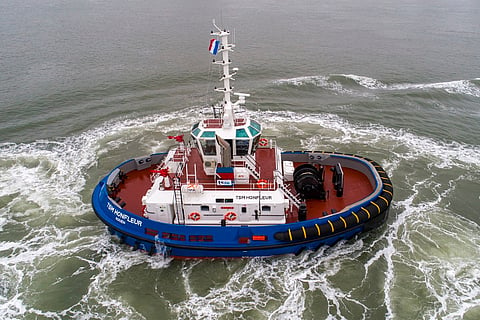

Damen Shipyards Group has delivered two new harbour tugs in a series to Thomas Services Maritimes (TSM), a family-owned maritime services company based in the French port city of Rouen. The tugs were built in response to TSM's need for newer vessels that not only possessed the latest towing technology, but were also capable of generating reduced emissions while on operations in line with the owner's goal of business activities with minimal adverse environmental impact.
Named TSM Honfleur and TSM Rouen, the tugs will be operated by TSM in the waters of the Seine River just off HAROPA – Port de Rouen, a port that lies between the ports of Honfleur and Rouen. Damen said the newbuilds will be used primarily to assist bulk carriers to facilitate the export of cereals from Rouen, currently the largest port in Western Europe in terms of grain exports, though the tugs will also be tasked to assist tankers and other commercial vessels inbound for the port.
The two newbuilds utilise a standard Damen 25- by 13-metre, seagoing reverse stern drive (RSD) tug design that has been modified with a draught reduced from 6.2 metres to 5.7 metres to enable easier navigation in shallower inland waters, such as the waters of the Seine. Damen said that even with this modification, recently completed sea trials proved that the two Caterpillar 2,525kW main diesel engines and the two Kongsberg fixed-pitch propellers fitted in each tug were still capable of delivering a bollard pull in excess of 80 tonnes as well as speeds of up to 13 knots.
TSM chief executive Loïc Thomas also claimed that the design of the tugs helps significantly reduce any vibrations caused by the engines, thus increasing the crew's comfort even during days of heavy use.
For towing, the tugs rely on a hydraulically-driven double drum winch that was developed in-house by Damen. This will enable low-speed pulling of 27 tonnes up to 30 metres per minute and high-speed pulling of 27 tonnes up to 49 metres per minute.
The two tugs are also each equipped with Damen's proprietary selective catalytic reduction (SCR) system that the builder said can help guarantee 70 per cent fewer NOx emissions compared to other IMO Tier II-compliant vessels. Damen, however, clarified that the tugs were designed from the outset to be able to accommodate modifications to ensure compliance to IMO Tier III standards in the future if the owner so wishes.
The tugs boast firefighting capability thanks to a main engine-driven pump and two monitors that can discharge water or foam at a rate of 1,200 cubic metres per hour.
The crew of six on each tug are comfortably housed in a captain's cabin, a chief engineer's cabin, and two double-berth cabins. Other onboard facilities include a pantry, a mess/dayroom, and toilets. All interior spaces including the wheelhouse and the switchroom have air conditioning while the wheelhouse also features a ceiling made from sound-absorbing material.
Two Caterpillar C4.4 81kVA generators provide power for the onboard systems and electronics including Furuno radar, echosounder, speed log, AIS, and inmarsat, Simrad autopilot and satellite compass/GPS, Jotron EPIRB and SART, and VHF radios from Jotron and Sailor. A Norselight 2,000W searchlight has been installed as well.
Construction of TSM Honfleur and TSM Rouen took place entirely at Damen Song Cam Shipyard located just outside the Vietnamese port city of Haiphong. The vessels were handed over to TSM in March 2021 and duly began operational sailings in support of HAROPA the following month. These are the 21st and 22nd vessels to join TSM's current active fleet.
| TSM Honfleur & TSM Rouen | |
| SPECIFICATIONS | |
| Type of vessel: | Harbour tugs |
| Flag: | France |
| Owner: | Thomas Services Maritimes, France |
| Operator: | Thomas Services Maritimes, France |
| Designer: | Damen Shipyards Group, Netherlands |
| Builder: | Damen Song Cam Shipyard, Vietnam |
| Hull construction material: | Steel |
| Superstructure construction material: | Steel |
| Deck construction material: | Steel |
| Length overall: | 24.73 metres |
| Beam: | 13.13 metres |
| Draught: | 5.7 metres |
| Displacement: | 570 tonnes |
| Main engines: | 2 x Caterpillar 3516C, each 2,525 kW at 1,800 rpm |
| Propulsion: | 2 x Kongsberg US 255 fixed-pitch propellers |
| Generators: | 2 x Caterpillar C4.4, each 81 kVA |
| Maximum speed: | 13 knots |
| Bollard pull: | 80 tonnes |
| Radar: | Furuno FAR-1518 |
| Depth sounder: | Furuno |
| Radios: | 2 x Sailor Compact 6222; Jotron TR-20 |
| Satcom: | Furuno |
| Autopilot: | Simrad AP-70 |
| Compasses: | Simrad; Cassens and Plath |
| GMDSS: | Jotron Tron 60S EPIRB; Jotron SART |
| GPS: | Simrad |
| AIS: | Furuno FA-170 |
| Other electronics: | Gill Instruments GMX 500 anenometer |
| Winch: | Damen double drum winch with wheelhouse controls |
| Fendering: | Cylindrical and block bow fender; D-fender on sides and aft |
| Other equipment installed: | Damen selective catalytic reduction system; air-conditioning unit; Azcue pumps; keel cooling and box cooling system |
| Paints/coatings: | Epoxy paint |
| Searchlight: | Norselight, 2,000 W |
| Floor/deck surface finishes: | Floating floors |
| Interior fitout/furnishings: | Sound-absorbing ceiling in wheelhouse |
| Firefighting equipment: | Main engine-driven pump; 2 x water/foam monitors |
| Type of fuel: | Diesel |
| Fuel capacity: | 77,500 litres |
| Freshwater capacity: | 10,200 litres |
| Sewage/blackwater capacity: | 6,000 litres |
| Accommodation: | Captain's cabin; chief engineer's cabin; 2 x double-berth cabins; pantry; mess/dayroom; toilets |
| Crew: | 6 |
